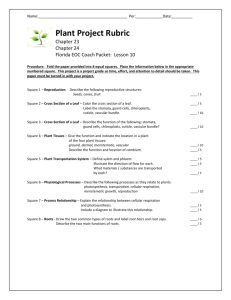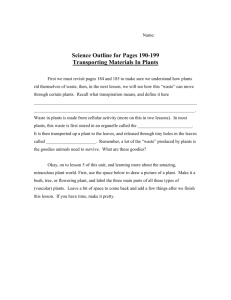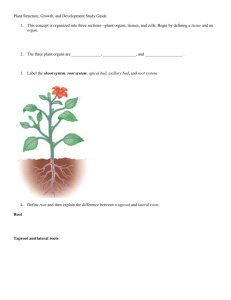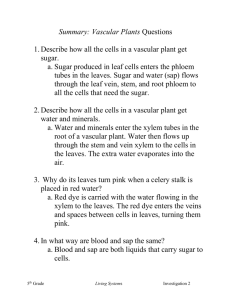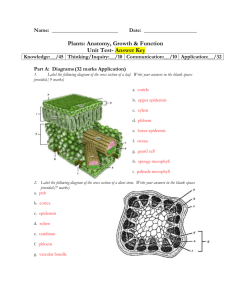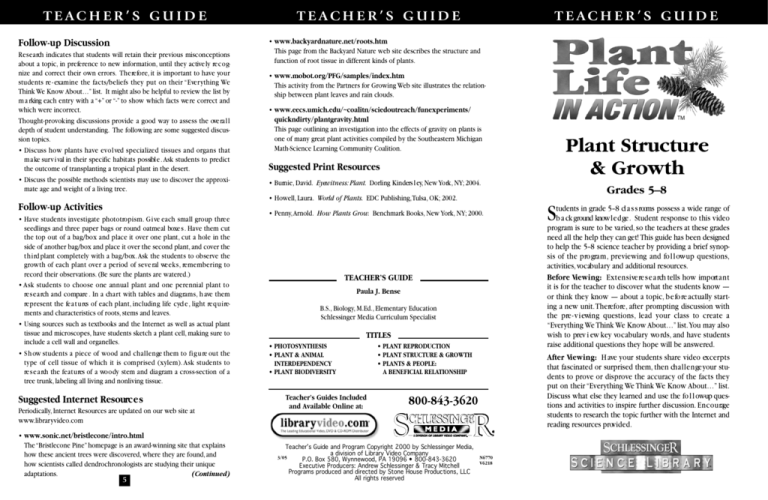
T E AC H E R ’ S G U I D E
Follow-up Discussion
R e s e a rch indicates that students will retain their previous misconceptions
about a topic, in pre fe rence to new information, until they active ly re c o gnize and correct their own errors. T h e re fo re, it is important to have yo u r
students re - examine the facts/beliefs they put on their “ E ve rything We
Think We Know About…” list. It might also be helpful to review the list by
m a rking each entry with a “+” or “-” to show which facts we re correct and
which were incorrect.
Thought-provoking discussions provide a good way to assess the ove ra l l
depth of student understanding. The following are some suggested discussion topics.
• Discuss how plants have evo l ved specialized tissues and organs that
m a ke surv i val in their specific habitats possibl e . Ask students to predict
the outcome of transplanting a tropical plant in the desert.
• Discuss the possible methods scientists may use to discover the approximate age and weight of a living tree.
TEACHER ’S G UIDE
T E AC H E R ’ S G U I D E
• www.backyardnature.net/roots.htm
This page from the Backyard Nature web site describes the structure and
function of root tissue in different kinds of plants.
• www.mobot.org/PFG/samples/index.htm
This activity from the Partners for Growing Web site illustrates the relationship between plant leaves and rain clouds.
• www.eecs.umich.edu/~coalitn/sciedoutreach/funexperiments/
quickndirty/plantgravity.html
This page outlining an investigation into the effects of gravity on plants is
one of many great plant activities compiled by the Southeastern Michigan
Math-Science Learning Community Coalition.
Plant Structure
& Growth
Suggested Print Resources
• Burnie, David. Eyewitness: Plant. Dorling Kinders l ey, New Yo rk , NY; 2004.
Grades 5–8
• Howell, Laura. World of Plants. EDC Publishing,Tulsa, OK; 2002.
Follow-up Activities
• Have students investigate phototro p i s m . G i ve each small group thre e
seedlings and three paper bags or round oatmeal boxe s . Have them cut
the top out of a bag/box and place it over one plant, cut a hole in the
side of another bag/box and place it over the second plant, and cover the
t h i rd plant completely with a bag / b ox . Ask the students to observe the
growth of each plant over a period of seve ral we e k s , re m e m b e ring to
record their observations. (Be sure the plants are watered.)
• Ask students to choose one annual plant and one perennial plant to
re s e a rch and compare . In a ch a rt with tables and diagra m s , h ave them
re p resent the fe a t u res of each plant, including life cycl e , light re q u i rements and characteristics of roots, stems and leaves.
• Using sources such as textbooks and the Internet as well as actual plant
tissue and microscopes, have students sketch a plant cell, making sure to
include a cell wall and organelles.
• S h ow students a piece of wood and ch a l l e n ge them to fi g u re out the
type of cell tissue of which it is comprised (xylem). Ask students to
re s e a rch the fe a t u res of a wo o dy stem and diagram a cross-section of a
tree trunk, labeling all living and nonliving tissue.
Suggested Internet Resourc e s
Periodically, Internet Resources are updated on our web site at
www.libraryvideo.com
• www.sonic.net/bristlecone/intro.html
The “Bristlecone Pine” homepage is an award-winning site that explains
how these ancient trees were discovered, where they are found, and
how scientists called dendrochronologists are studying their unique
adaptations.
(Continued)
5
• Penny,Arnold. How Plants Grow. Benchmark Books, New York, NY; 2000.
TEACHER’S GUIDE
Paula J. Bense
B.S., Biology, M.Ed., Elementary Education
Schlessinger Media Curriculum Specialist
TITLES
• PHOTOSYNTHESIS
• PLANT & ANIMAL
INTERDEPENDENCY
• PLANT BIODIVERSITY
Teacher’s Guides Included
and Available Online at:
• PLANT REPRODUCTION
• PLANT STRUCTURE & GROWTH
• PLANTS & PEOPLE:
A BENEFICIAL RELATIONSHIP
tudents in grade 5–8 cl a s s rooms possess a wide range of
b a ck ground know l e d ge . Student response to this video
program is sure to be va ried, so the teach e rs at these grades
need all the help they can get! This guide has been designed
to help the 5–8 science teacher by providing a brief synopsis of the pro gra m , previewing and fo l l ow-up questions,
activities, vo c ab u l a ry and additional resources.
Before Viewing: E x t e n s i ve re s e a rch tells how import a n t
it is for the teacher to discover what the students know —
or think they know — about a topic, b e fo re actually starting a new unit.Therefo re , after prompting discussion with
the pre - v i ewing questions, lead your class to create a
“Everything We Think We Know About…” list.You may also
wish to prev i ew key vo c abulary wo rds, and have students
raise additional questions they hope will be answered.
After Vi e w i n g : H ave your students share video excerpts
that fascinated or surprised them, then ch a l l e n ge your students to prove or disprove the accuracy of the facts they
put on their “Everything We Think We Know About…” list.
Discuss what else they learned and use the fo l l ow-up questions and activities to inspire further discussion. E n c o u rage
students to research the topic further with the Internet and
reading resources provided.
800-843-3620
Teacher’s Guide and Program Copyright 2000 by Schlessinger Media,
a division of Library Video Company
P.O. Box 580, Wynnewood, PA 19096 • 800-843-3620
Executive Producers: Andrew Schlessinger & Tracy Mitchell
Programs produced and directed by Stone House Productions, LLC
All rights reserved
3/05
S
N6770
V6218
epidermis — The protective outer layer of leaf cells, including the guard cells
surrounding the stomata.
(Continued)
algae — The primitive photosynthetic organisms from which green plants
have evolved.
vascular plants — Plants that have a specialized system of tissues that allow
the movement of water and nu t rients from different parts of the plant.These
tissues includes xylem and phloem.
nonvascular plants — Primitive plants without a specialized system of conducting tissue; nonvascular plants are closely linked to the water for their survival.
xylem — The complex tissue in vascular plants that conducts water and diss o l ved minerals from the roots to the stem and leave s , while also support i n g
the stem.
phloem — The complex tissue in the vascular plants that functions in the
movement of sugars from the leaf into other areas of the plant.
root tip — The area of a plant root that is capable of growth.
root cap — A protective layer of tissue at the root tip of a plant.
root hairs — Thin root cells that function primarily by absorbing water.
taproot — A main root that grows downward and gives off small side roots.
fibrous roots — A root system that bra n ches in many directions with no
central root.
geotropism — The movement of a plant in response to gravity.
phototropism — The movement of a plant in response to light.
thigmatropism — The movement of a plant in response to touch.
simple leaves — Leaves comprised of one part.
compound leaves — Leaves comprised of two or more separate parts, called
leaflets.
cuticle — The waxy protective covering on the epidermis of a leaf.
mesophyll — The middle layers of leaf tissue, i n cluding the palisade laye r
and spongy layer.
palisade layer — The upper layer of mesophyll containing cells that are filled
with chloroplasts and carry on most of the photosynthesis in a leaf.
spongy mesophyll — A loose layer of leaf cells below the palisade layer that
typically contains the xylem and phloem.
chloroplast — The specialized stru c t u re found in plant cells where photosynthesis takes place.
stomata (singular: stoma) — Small openings or pores found on the underside of a leaf that allow carbon dioxide to enter the leaf as well as the release
of oxygen and water vapor.
guard cells — Cells that control the exchange of gases between the leaf and
the surrounding atmosphere by regulating the opening and closing of the
stomata.
photosynthesis — The process by which green plants use light energy from
the sun to make their own food out of carbon dioxide and water.
transpiration — The evaporation of water from a plant through stomata.
2
3
P rogram Summary
There are at least 310,000 named species of plants on Earth and botanists are
still counting! How is it possible to sort out the characteristics of so many diffe rent living things? Computer wizard Anna Gibson and her lab partner Ja ck
are hoping to learn about the structure and growth of plants but are feeling
ove r w h e l m e d . What could huge trees possibly have in common with tiny
mosses? With the help of scientist Dr. Figg and her computer, Anna realizes
that scientific answe rs are not always easy to see with the naked eye . After
some research, she discovers that all plants are multi-celled and they all have
p ro t e c t i ve , ri gid cell walls made of cellulose. She discove rs that green plants
contain chlorophyll, a pigment that allows them to trap the energy of the sun.
Ja ck mentions another unique ch a ra c t e ristic of plants — the fact that they
continue to grow throughout their lifetimes.
Using a micro s c o p e , Ja ck and Anna observe plant cells organized into tissues
and further specialized into stru c t u res called organs, e a ch designed to
p e r fo rm a job within the plant. They focus their attention on three plant
o rgans — stems, roots and leave s . Vascular plants have xylem tissue which
m oves water from the roots into the stem and leave s , and phloem tissue
w h i ch transports sugars from where they are made in the leaf to the rest of
the plant.This vascular system is similar to the veins running through a human
b o dy, and it also provides stem support , a l l owing some trees to grow to gi a n t
p ro p o rtions. Roots are re s p o n s i ble for water absorption in plants. Roots also
act as a plant’s anchor and can serve as a food storage system. Ja ck and Anna
wo rk together to investigate the effect of gravity on roots in a simple experiment and they learn about plant responses to factors such as light and touch.
Next, they discover that leaves are the “food factories” of the plant world, and
l e a rn that while leaves may look ve ry diffe rent from tree to tre e , they are all
comprised of the same types of cells.
Vocabulary
The fo l l owing wo rds are included for teacher re fe rence or for use with students. They are listed in the order in which they appear in the video.
cell wall — The ri gi d , nonliving, permeable structure that surrounds the cell
membrane of plant cells, primarily made of cellulose.
cellulose — A complex chain of sugar molecules that constitutes the ch i e f
part of the cell walls of plants.
chlorophyll — The green pigment found in ch l o roplasts that absorbs sunlight used during the first step of photosynthesis.
tissues — Cells of a particular kind that fo rm one of the stru c t u ral materi a l s
or organs of a plant.
organs — Specialized tissue that performs a specific function in an organism
like a plant.
P re-viewing Discussion
B e fo re students ge n e rate their list of “ E ve rything We Think We Know
About…” for this topic, s t i mulate and focus their thinking by raising these
questions so that their list will better reflect the key ideas in this show:
• What do all plants have in common?
• What type of organism is considered to be the world’s oldest living thing?
• What is the largest living thing in the world?
After the class has completed their “ E ve rything We Think We Know
About…” list, ask them what other questions they have that they hope will
be answe red during this pro gram. H ave students listen closely to learn if
eve rything on their class list is accurate and to hear if any of their ow n
questions are answered.
Focus Questions
1. How many species of plants have been identified?
2. What does a huge oak tree have in common with tiny moss?
3. How are plant cells different from animal cells?
4. What is chlorophyll?
5. When did plants evolve from green algae?
6. What is the relationship between algae and water?
7. What is a vascular system?
8. How are nonvascular plants different from vascular plants?
9. What is the largest living thing in the world?
10. What are the two types of vascular plant tissue?
11. What is the role of the xylem?
12. What is the role of the phloem?
13. How can a stem differ from plant to plant?
14. How are the rings in a tree trunk formed?
15. What is the relationship between the size of a tree ring and the
amount of rainfall in a season?
16. Where does water enter a plant?
17. Why are roots important to a plant?
18. What is the difference between fibrous roots and taproots?
19. Can plants react to their surroundings? Explain.
20. What is a tropism?
21. What is the difference between a simple leaf and a compound leaf?
22. What are some important features of each layer of the mesophyll?
23. What is the function of the stomata? Where are they typically located?
24. How does transpiration take place in a leaf?
4


